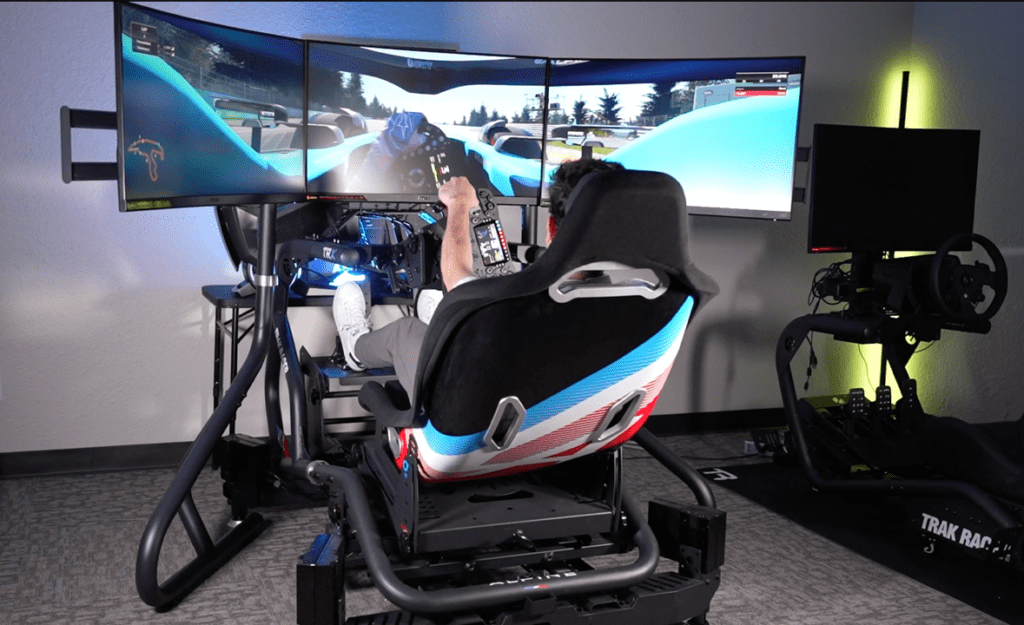Table of Contents
ToggleGetting Started with Your Sim Racing Setup
Starting out in sim racing with a dedicated sim racing setup can be an exciting hobby that allows you to experience the thrill of motorsports from the comfort of your home. Whether you’re a casual gamer or an aspiring professional racer, setting up your sim racing setup correctly is essential to maximize your performance and enjoyment. This guide will walk you through the steps to get started, including choosing the right equipment, setting up your rig, and installing the necessary software.
Choosing the Right Equipment
The quality of your sim racing setup heavily depends on the equipment you choose. Here are the key components you’ll need:
Steering Wheel
The steering wheel is perhaps the most critical piece of equipment for your sim racing setup. It provides the primary interface between you and the virtual car. If you’re just starting, consider an entry-level wheel like the Logitech G29/G920 or the Thrustmaster T300. These wheels offer good feedback and are relatively affordable. For a more immersive experience, entry-level Direct Drive wheelbases from Fanatec and Moza provide better force feedback and more robust construction. Serious sim racers might invest in high-end wheels like the Fanatec Clubsport series or the Simucube 2, which offer the best force feedback and build quality.
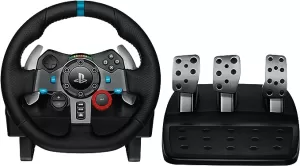
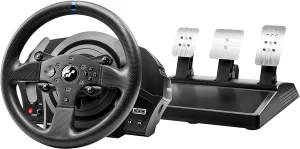
Pedals
Pedals are crucial for controlling acceleration, braking, and clutching (if applicable). Most entry-level wheels come with basic pedal sets. While these are adequate for beginners, they often lack precision and durability. For a significant upgrade, consider load cell pedals, like those offered by Fanatec. Load cells measure the force applied rather than the distance travelled, providing much more accurate braking. High-end pedal sets, such as those from Heusinkveld Engineering, offer unparalleled precision and customization options.

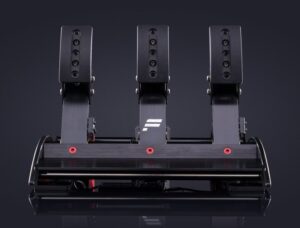
Racing Seat
A comfortable and supportive racing seat is essential for long racing sessions. Initially, a sturdy office chair might suffice, but it won’t provide the support needed for extended racing sessions. Specialized racing seats, like those from Playseat or GT Omega, offer better ergonomics and immersion. Some sim racers opt to build their rigs using real car seats and custom mounts for a personalized experience. With the evolution of powerful direct-drive wheelbases, full aluminium rigs are now available that are extremely robust and can create a fully immersive racing experience.
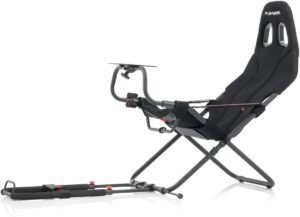
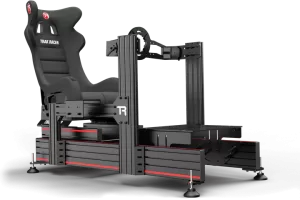
Additional Accessories
To further enhance your sim racing setup, consider adding additional accessories like shifters and handbrakes, especially if you enjoy driving cars with manual transmissions. Popular options include the Thrustmaster TH8A and the Fanatec Clubsport Shifter. A high-quality monitor or a VR headset can drastically improve immersion. Triple monitor setups are popular among sim racers for the wider field of view, while VR headsets like the Oculus Rift or the PSVR 2 for PS5 offer a fully immersive experience. Good sound can also enhance the realism of sim racing, so a surround sound system or quality headphones are recommended.
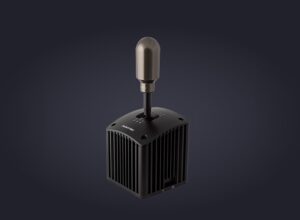
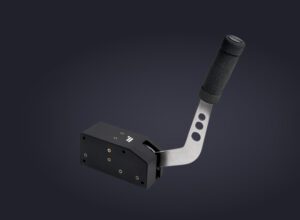

Setting Up Your Sim Racing Rig
Once you’ve selected your equipment, it’s time to set up your sim racing rig. Here’s a step-by-step guide:
Assembling Your Rig
Start by mounting your wheel and pedals to a stable surface. If you have a dedicated cockpit, follow the manufacturer’s instructions for mounting. Ensure the wheel is at a comfortable height and distance, and the pedals are positioned for comfortable and precise control. If you have a racing seat, adjust it to ensure a comfortable and ergonomic driving position. Your back should be well-supported, and your legs should have a slight bend when the pedals are fully depressed. Organize your cables to avoid tangling and tripping hazards. Use cable ties and clips to keep everything neat.
Adjusting the Settings
Follow the instructions provided with your wheel to calibrate it properly. This usually involves centring the wheel and setting the rotation range. Most modern wheels have software that guides you through this process. Similarly, calibrate your pedals to ensure they respond accurately to your inputs. Some high-end pedal sets offer software for fine-tuning the sensitivity and dead zones. Adjust the force feedback settings to suit your preferences. Strong force feedback can enhance realism but may cause fatigue over long sessions. Experiment with different levels to find the right balance.
Setting Up Your Display
For a single monitor, place it at eye level, directly in front of your racing seat. The distance should be such that you can comfortably see the entire screen without straining your eyes. If you’re using three monitors, angle the side monitors to create a wrap-around effect. This setup offers a wider field of view, improving immersion and situational awareness. If you opt for a VR headset, ensure your play area is clear of obstacles. Follow the manufacturer’s instructions for setting up the headset and sensors.
Installing the Necessary Software
With your hardware set up, the next step is to install the software. This includes the racing simulators themselves and any additional software needed for your hardware.
Popular Racing Simulators
- Assetto Corsa: Known for its realistic physics and modding community, making it a favourite among sim racers. It offers a wide range of cars and tracks, with additional content available through mods.
- iRacing: A subscription-based service that focuses on realism and competitive online racing. It has a steep learning curve but is highly rewarding for serious racers.
- rFactor 2: Another highly realistic simulator, known for its dynamic weather and track conditions. It’s a bit more niche but highly regarded in the sim racing community.
- F1 Games from Codemasters: These games offer a great racing experience even if they aren’t full racing simulators, with great esports racing online competitions.
Installing and Configuring the Software
Purchase and download your chosen simulator from a reputable source, such as Steam. Follow the on-screen instructions to install the game. Once installed, configure your wheel, pedals, and any other peripherals in the game’s settings. Most simulators have built-in presets for popular hardware, making this process straightforward. Adjust the graphics settings to balance performance and visual quality to match your display. Additionally, physical disc copies can be purchased for most games for console users, call me nostalgic but this is always my preferred option.
Additional Software
Install the latest drivers for your wheel and pedals. Manufacturers like Logitech, Thrustmaster, and Fanatec provide these on their websites. Tools like Track Titan can help analyze your driving performance. These tools provide detailed telemetry data, allowing you to fine-tune your technique. If you plan to race online, consider using a voice communication tool like Discord or TeamSpeak to communicate with other racers, remember to keep comments clean and respectful.
Tips for Improving Your Sim Racing Setup Experience
- Practice Regularly: Like any skill, sim racing requires practice. Spend time on different tracks and with different cars to improve your skills.
- Engage with the Community: The sim racing community can provide valuable tips and support. Forums like RaceDepartment and iRacing’s community forums are great places to start, there are also many social media groups dedicated to certain sim titles.
- Participate in Online Races: Participating in online races can be a great way to test your skills against real opponents. It also adds an extra layer of excitement and challenge.
- Use Telemetry and Analysis Tools: Review your performance and identify areas for improvement. Work on them systematically.

Differences Between Simcade and Full Racing Sims
Simcade games and full racing simulators differ significantly in their approach to realism and accessibility. Simcade games, a blend of “simulation” and “arcade,” strive to balance realistic driving mechanics with accessible, enjoyable gameplay. Titles like “Forza Horizon” and “Gran Turismo” are designed to appeal to a broad audience, offering a blend of realistic vehicle physics and more forgiving, user-friendly controls. These games often include features like driving aids and more lenient damage models, making them ideal for casual players and those new to racing games.
In contrast, full racing simulators like “iRacing,” “Assetto Corsa,” and “rFactor 2” focus on providing an authentic, highly detailed racing experience. These sims prioritize realism in every aspect, from tyre and suspension physics to weather conditions and track surface changes. They often require more advanced hardware setups and a higher skill level, appealing to dedicated sim racers who seek a true-to-life driving experience. This emphasis on accuracy and immersion makes full racing sims the preferred choice for serious enthusiasts and professional racers looking to hone their skills.
Conclusion
Creating your sim racing setup involves careful consideration of your equipment, meticulous setup, and installing the right software. By choosing the right components, setting them up correctly, and practising regularly, you can create an immersive and rewarding sim racing setup. Whether you’re racing for fun or aspiring to compete at a high level, the right setup will help you get the most out of your virtual racing adventures.
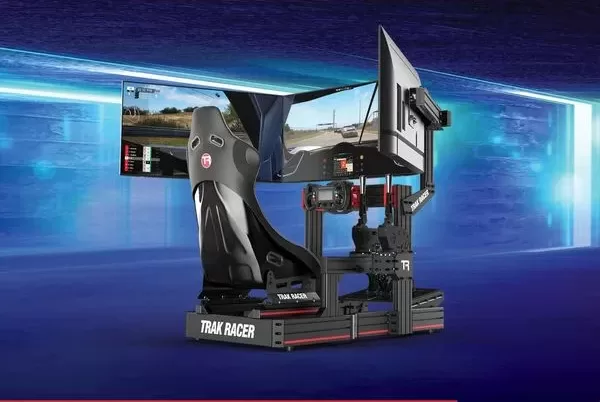
Stay Connected and Sharpen Your Skills
If you’re finding this guide helpful, stay tuned for more in-depth how-to posts, including driving techniques for all skill levels—whether you’re just diving into sim racing or are at an intermediate level. There are techniques suited for everyone to help you hit that perfect lap and nail those purple sector times. Don’t miss my other product review posts, and let’s connect—your thoughts and experiences are always welcome, and if you enjoyed this content, consider sharing my website and product review posts with others on social media!

